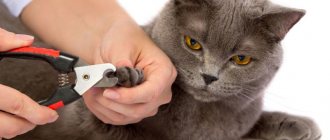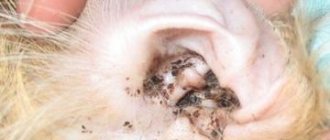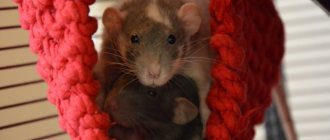Not every owner has the courage to clean a cat’s ears. In most cases, this is due to inability or lack of time. Veterinarians advise cleaning their pets’ ears once a week. Upon closer inspection, it is a simple procedure that does not require a trip to the veterinarian's salon or clinic.
Need for cleaning
Should cats' ears be cleaned and why? The hearing aid has a very complex structure, hence there are so many practical questions.
Like other mammals, cats have glands that produce a special secretion - sulfur. This is a natural process necessary to protect the middle ear from dust, foreign particles and harmful microorganisms. Sulfur is released naturally during chewing of food, and the animal itself removes its excess while washing.
The process does not always go smoothly, and some individuals require the help of the owner.
Hygiene
Often the secretion that is not released accumulates, forming sulfur plugs, leading to hearing impairment. By putting pressure on the eardrum, the plug provokes unpleasant sensations in the form of pain, nausea, and dizziness.
It should be remembered that the auditory canal, in addition to the perception of sound, performs another function - it is responsible for the position of the body in space and the ability to maintain balance. In other words, it is closely connected with the vestibular apparatus, so if cleaning is not carried out on time, it can lead to deterioration of coordination.
Hygienic cleaning is performed if necessary - if the owner of the animal notices accumulations of wax in the ear. The ear needs to be examined weekly: if there is a dark or yellowish coating, it is carefully removed without going deep.
Prevention and treatment of diseases
The first examinations must begin at an early age, trying to accustom the kitten to the procedure, since it must be performed constantly. If you do not regularly inspect and clean, parasites may appear in the ear canal - wax is a good breeding ground for ear mites.
The increased attention of the four-legged animal to its “locators” can be considered an alarm bell. The animal begins to constantly itch, trying to get something out of the ear canal, or shake its head. If you observe such symptoms, take your mustachioed friend to the veterinarian immediately.
When treating ear diseases, you need to clean them 1-2 times a day with special products. The veterinarian will prescribe a regimen of procedures in accordance with the identified pathology.
Frequency of procedure
The amount of sulfur produced is influenced by many factors: breed, diet, activity, environment. Since the cat's “locator” is very sensitive to touch, too frequent intervention can cause unpleasant associations. Therefore, owners are worried about how often to clean their cat’s ears so as not to cause harm and not miss the onset of the disease?
There is no consensus among veterinarians. A lot depends on the breed of the pet - for example, hairless cats do not have hairs in their shells, so they produce an excess amount of sulfur for better protection.
Fold-eared breeds also need close attention - their ear canal is covered, and therefore ventilation is difficult. Also, increased secretion of sulfur is observed in older animals, individuals with chronic diseases, and in cats who have suffered from ear mites.
Accordingly, for such pets, inspection is carried out every two to three days, and cleaning is done every three to four days. For other breeds, an inspection once a week is sufficient. Do not confuse examination and cleaning - it is quite possible that your pet will only need intervention once every 3-4 months.
Cleaning ears at the veterinary clinic
The list of services provided by veterinary clinics includes a hygienic procedure - ear cleaning.
Veterinarians believe that it is necessary to carry out a professional examination of the animal at least once every two weeks, so that if any disease is detected in it, they can provide the animal with timely qualified assistance and prevent complications.
How much does it cost to clean a cat's ears at the vet? clinic, depends on the neglect of the case and on the pricing policy of the institutions themselves.
A loving, good owner takes care of his pet, regularly monitors its health and, if necessary, will always seek qualified help from a veterinary clinic.
Cat ear cleaners
There are a large number of remedies: some are intended for prevention, others for the treatment of diseases. The former can be purchased at a veterinary pharmacy or pet store, the latter must be purchased in accordance with the recommendations of a veterinarian.
For diseases
In case of serious illnesses, it is better to immediately contact a veterinarian. Before your initial visit to the clinic, it is better not to remove the contents of the auricle, as this may complicate the diagnosis.
Any medicinal prescriptions must be made by a doctor. Incorrect, self-selected treatment can cause bacteria to become resistant to antibiotics, as well as chronic inflammatory processes.
For hygienic purposes
For regular cleaning, available products are suitable: chlorhexidine or Vaseline. For more thorough cleaning, you can use medications from veterinary pharmacies: drops and lotions. Products are often released as sprays, which simplifies the cleaning process.
Toilet and hygiene
A significant point in preparing a place for the Scottish Fold is the toilet. You should not choose trays with sides that are too high or low . Too low sides make the tray unhygienic, and a small cat simply cannot climb into a tray that is too high. When it comes to fillers, give preference to natural options. Clay, which rolls into lumps when used, and sawdust granules, which, on the contrary, crumble when used, work well. To quickly accustom your Scottish Fold to the toilet, ask the seller in advance what kind of litter he used to accustom the animal to. Use the same in your home.
It is best to place the tray in the toilet on a slight elevation. This way, the pet will not only do its business, but will also stretch its spine every time, which is especially important for this breed. When cleaning, rinse the tray with water and wash it with soap and water from time to time.
As a rule, cats learn to wash themselves, and therefore for the rest you should adhere to the recommendations standard for all cats.
How does the procedure work?
Since cleaning a cat’s ears at home is not at all difficult, owners can do it on their own. If the cat has been trained since childhood, hygiene measures can be easily carried out alone. For a stubborn animal, two people will most likely be needed.
Preparation
First you need to prepare all the tools and tools. Bottles and drops must be opened to act as quickly as possible.
Choose a place for the event - a quiet and bright room will do. If the procedure takes place in the dark, prepare a good lamp. Place it comfortably and steadily so that the light falls on the animal.
Next, gently secure your pet. This can be done by sitting him on your lap and squeezing him slightly towards you. If your pet breaks out and it becomes difficult to hold him, then available means will come to the rescue. You can swaddle your four-legged dog with a towel, protecting yourself from claws and teeth. Holding the animal's head with one hand, you can carry out the procedure with the other hand.
Another option is a retainer bag. It will free both hands of the owner and allow you to quickly carry out any hygiene procedure.
The third option is to enlist the help of household members. One person will hold and calm the cat while the other quickly examines and, if necessary, cleans the ears.
Algorithm of actions
After the mustachioed friend is immobilized and does not pose a threat to the owner, you can proceed to the main steps:
1.
Inspect the ear for discharge, scratches, or injuries. To do this, carefully turn it out. This is not dangerous and will not harm your mustachioed friend.
What you need to pay attention to:
- an unpleasant odor indicates suppuration or malignant formations;
- blood discharge: blood occurs with dermatitis and otodectosis, when the animal begins to scratch the affected areas vigorously, injuring the skin;
- tumor - looks like a hard nodule.
2.
Soak a napkin in the lotion and then squeeze it out so that excess moisture does not remain inside. Another option is to buy impregnated veterinary wipes.
3.
Gently rub a napkin or cotton pad over the contaminated areas. There is no need to penetrate deep into the ear canal, as this may subsequently cause the formation of wax plugs. The entire procedure must be performed within sight. Small stains can be removed with a cotton swab - but only from the outside.
4.
After the procedure, praise the animal and give it a treat. The pet should be left with a positive impression - he was not hurt, and then he was given a treat. Next time he will take the cleaning more calmly.
There is another option for cleaning your cat's ears at home. This method is appropriate when a lot of dust and dark secretions have accumulated:
- Take the drops and warm them to a comfortable (slightly above room) temperature. The solution should not be cold or hot.
- Drop the liquid into the ear canal and gently massage the base of the ear so that the medicine penetrates inside.
- Shake your pet's head to shake out excess solution. The bulk of the contamination will come out. If you need to remove residue, use a cotton swab. It is important not to make sharp circular movements so as not to injure the auditory organ.
Always be as gentle as possible with your pet, as such manipulations are stressful for them. Over time, when the cat gets used to it, everything will be perceived much easier for him.
How to clean a kitten's ears
How to clean a kitten's ears? Just like an adult cat, cleaning a baby’s ears is not difficult. But you need to act more delicately. Firstly, kittens have smaller ear canals, which means the cotton swabs will be too big. Secondly, you need to be careful when restraining a small pet.
Drops that are gently dripped into the ear canal and onto the inner surface are well suited for the procedure. After instillation, it is necessary to massage the shell for several minutes - for better penetration of the medicine. As with adult cats, it is best to massage at the base.
After this, release the kitten and let him shake his head so that the medicine along with the contamination comes out. Then wipe the kitten's head with a towel or cotton pad.
There is no need to thoroughly clean dirt from kittens - you risk causing damage. If the dirt has accumulated deeply, it is better to seek help from a veterinarian.
What not to do
There are a number of actions that absolutely cannot be performed:
- Under no circumstances should you wash your hearing organ with plain water. Always keep an eye on this when swimming - water should not get inside. It can provoke inflammation and suppuration, that is, otitis media.
- Chlorhexidine is not suitable for instillation. It should only be used for external cleaning.
- Do not use hydrogen peroxide, soap or alcohol-containing solutions. “Traditional medicine” can greatly harm your mustachioed friend: they dry out the skin, kill natural microflora and cause an allergic reaction.
- When restraining the animal, always make sure that it has something to breathe. The animal should be in a position that is comfortable for it.
Never forget the importance of the above-mentioned nuances. With some skill, you will learn how to check and clean your pet's ears quickly and without stress for both of you.
Lifehack
It's a rare cat who likes to have his ears cleaned. Most often, pets consider this action as unauthorized access to their holy of holies, along with the anus or testicles. Therefore, you have to act accurately and correctly. To begin, sit the cat on your lap, stroke it, caress it. During the procedure, talk to him gently at all times.
The cat will not just let you do something with it. Most often, he will press his ears back - as a result, you will not be able to put anything there. Plus the cat will back away to run away and rub its head with its paws, because... he's ticklish. To prevent the cat from running away, you can put his butt next to your body - now there is nowhere to back away. In extreme cases, you will have to squeeze it with your feet or wrap it in a blanket like a shawarma. In some cases you have to call for help.
To stop the cat’s attempts to press its ears and prevent you from performing manipulations in this way, you need to immediately turn the ear outward: this does not hurt the cat, but it gives a beautiful view of the auricle. After the procedure, reward your cat with a treat so that the procedure is associated with a pleasant ending.
Features of caring for fold-eared cats
Fold cat ears are cleaned in the same way as any other pet. The nuance is that such breeds are not able to wash the “locators” themselves due to the unusual structure of the auricle. More frequent inspection and close attention will be required.
Proceed as usual. To begin, turn the ear outward (as it should be when properly cleaning a cat’s ears) and use a flashlight to illuminate the ear canal. Be careful - cats' cartilage is very delicate. If you notice plaque and dirt, remove it as you would a regular cat.
After the procedure, you will have to thoroughly dry the folded ear, because excess moisture can lead to diaper rash and the rapid formation of diseases.
Who suffers from ear problems most often?
Ear mites are transmitted from other animals through close contact. Most often, it affects cats that are often outdoors, living in nurseries or shelters. When bringing a new pet into your home, it should be quarantined for a while. This can protect other cats not only from tick infection, but also from other serious diseases.
Otitis media occurs when hygiene standards are not followed, when the pet is kept in a cool room or in a draft.
When bathing your pet, you need to protect its ears from water getting into them. After water procedures, you should immediately clean your cats ears with a dry soft cloth.
Kittens, old cats, or weakened animals suffer the most. In addition, some breeds of cats that have large ears or lack fur are susceptible to ear diseases. These are the Sphynx, Devon Rex, Maine Coon, Somali, Abyssinian and Oriental cats.
What is not allowed during processing is prohibited
The ears of adults and kittens are sensitive and need careful attention. Doctors do not recommend when cleaning:
- use soap, iodine, vinegar, alcohol lotions, hydrogen peroxide. These drugs can cause irritation and dryness;
- use cotton swabs, wrap cotton wool around matches. This can damage the eardrum or push debris into the ear canal instead of out.
Lumps or discharge in the ears are a signal to consult with veterinarians at veterinary clinics.
Symptoms of diseases
It is worth paying attention to the health of your pet if:
- redness of the skin;
- increased temperature in certain parts of the body;
- narrowing of the auditory canal;
- tumors;
- change in the color of sulfur;
- unpleasant strong odors;
- squelching sound when pressing;
- excessive sulfur secretion;
- accumulations of pus and fluid;
- various secretions with blood;
- decreased ability to perceive sounds;
- changes in behavior: the cat shakes its head or tilts it to one side, pulls its ear away or runs away when touched, often itches;
- black sulfur, streaks with impurities are a sign of a mite.
Black inclusions in sulfur are often ordinary dirt. If, after cleansing, minor inflammations remain on the skin, you should seek help from a specialist.
Colorless or milky discharge indicates a lack of microelements or vitamins.
Dry ears and waxy scales indicate dermatitis, as well as a lack of fat in the diet.
Allergies are indicated by colorless discharge from the nose, eyes, and ears.
The ears smell like fish if there is a staphylococcus infection, and rotten meat when there is suppuration.
Only a veterinarian can indicate the true cause of ill health and prescribe the correct treatment, so any of these symptoms require consultation.
Structure of a cat's ear
A cat's ears resemble human ears in structure and include:
- external, consisting of a funnel-shaped shell covered with wool with guard hairs inside and the auditory canal;
- in the middle there is an eardrum and a bone cavity with three bones, important in the perception of noise;
- internal - the most complex section, in which the vestibular apparatus and sound receptors are located.
In animals, the auditory canal, unlike the short human one, is curved and forms an angle. Improper cleaning can lead to wax buildup and blockage of the passage.
Cats can hear sound vibrations in the range of 20–100,000 Hz. Muscles and cartilage are able to rotate the shell to pinpoint the source of sound vibrations during hunting.











